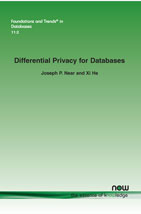Differential Privacy for Databases
By Joseph P. Near, University of Vermont, USA, jnear@uvm.edu | Xi He, University of Waterloo, Canada, xi.he@uwaterloo.ca
Abstract
Differential privacy is a promising approach to formalizing privacy—that is, for writing down what privacy means as a mathematical equation. This book is provides overview of differential privacy techniques for answering database-style queries. Within this area, we describe useful algorithms and their applications, and systems and tools that implement them.
Differential Privacy for Databases
Differential privacy is a promising approach to formalizing privacy—that is, for writing down what privacy means as a mathematical equation. This book serves as an overview of the state-of-the-art in techniques for differential privacy. The authors provide an introduction to what is meant by privacy in computing terms and the reasons why differential privacy is becoming adopted in many applications.
The authors focus in particular on techniques for answering database-style queries, on useful algorithms and their applications, and on systems and tools that implement them. These techniques represent significant progress towards building differentially private database systems. The approaches described in this book have already resulted in useful, deployable systems, and likely pave the way towards increasingly widespread adoption of differential privacy in such systems.
This book provides a database researcher or designer a complete, yet concise, overview of differential privacy and its deployment in database systems. Written in a clear and didactic manner, the novice to the subject will quickly learn the essentials; while those more familiar with the subject is presented with an accessible text that covers the latest research.
